When is a tree not a tree?
When it’s a hazard.
We love trees and think everyone else should, too. Trees give us oxygen, cool air, shade, food, firewood, furniture, and wine corks, and put us in a better mood. But when a tree is damaged or its health declines, it can become dangerous to be around.
Often, that’s because a tree’s internal damage can’t be fully evaluated from the outside, and the behavior of a declining tree can’t be predicted. Learning to identify signs of serious damage means your trees may be prevented from becoming a hazard or can be removed before they damage anyone or anything.
But first, remember that a tree isn’t a hazard unless there is someone or something within its range that can be killed, injured, damaged, or destroyed. Not every “dangerous tree” is classified as a “hazard tree.” Here are two examples –
- A tree standing alone in an empty field that suddenly falls over? Not a hazard
- A tree standing in an empty field that suddenly falls over, while puppies are cavorting around its base? Hazard
WHAT YOU SHOULD KNOW ABOUT HAZARD TREES
Visible Signs to Look For
There are several visible signs that a tree might be a hazard. They are:
- Root damage
- Poor crown form
- Cracked or split bark
- Dead wood
- Cankers
- Weak branch attachment or co-dominant leaders
- Decay
Here’s what to look for to determine whether or not your tree is a hazard. And remember, if in doubt, bring in a Certified Arborist ASAP.
ROOTS
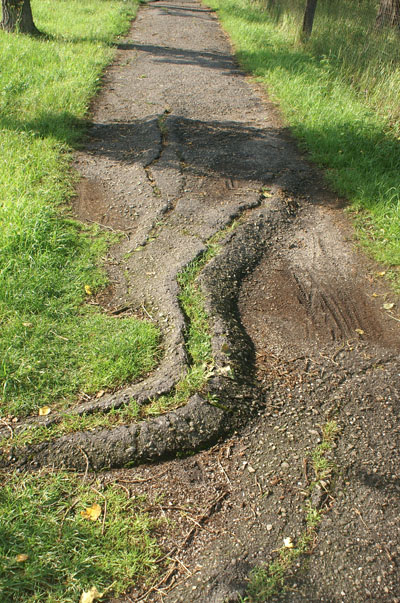
Paving over tree roots can damage the tree, eventually leading to decline and making it a hazard
A tree’s root system is its lifeline. Without a strong and healthy root system, a tree can become unbalanced and hazardous.
A damaged root system makes a tree likely to fall over in a windstorm, or even from the weight of its own branches and leaves. Damage occurs in many different ways, including:
- when tree roots are severed to install paving or for other construction trenching,
- when roots are paved over,
- when people walk over and vehicles park atop surface roots, and
- when roots decay and no longer act as supports.
Symptoms of root damage may be seen in the crown of a tree in the form of branch die-back, as well as leaves that are yellowed or browned and smaller than normal. These are signs that roots are not providing the water and nutrients needed by the tree.
Call an arborist right away if you notice that your trees –
- Lean to one side
- Drop branches
- Have had major and/or many roots cut off for paving or trenching
- Have exposed roots or roots with visible decay
CROWN SHAPE
A tree with an uneven or misshapen form can be a hazard if its internal structure is damaged. A misshapen form can result from bad pruning or topping cuts, storm damage, and bad growing conditions.
Bad pruning can result in lots of water sprouts, or suckering branches that are not strongly attached.
An example of bad growing conditions is a tree growing in too much shade, where its branches grow weakly and unevenly up and out in search of sunlight.
An uneven tree crown means that weight is unevenly distributed and the tree may not be able to support itself. Large, overgrown branches or branches with growth only at their tips contribute to this imbalance.
Get your trees evaluated immediately if they –
- Lean over to one side
- Have large side branches that have overtaken the central leading branch’s size
- Have been topped, or have heading cuts and water sprouts
CRACKED BARK
A tree’s biggest protection is its bark. Bark keeps insects and disease from getting in, cushions against injury, and moderates a tree’s internal temperature. When a tree’s bark cracks or splits, it exposes its internal wood to decay, and can signal that larger problems have already damaged the tree internally.
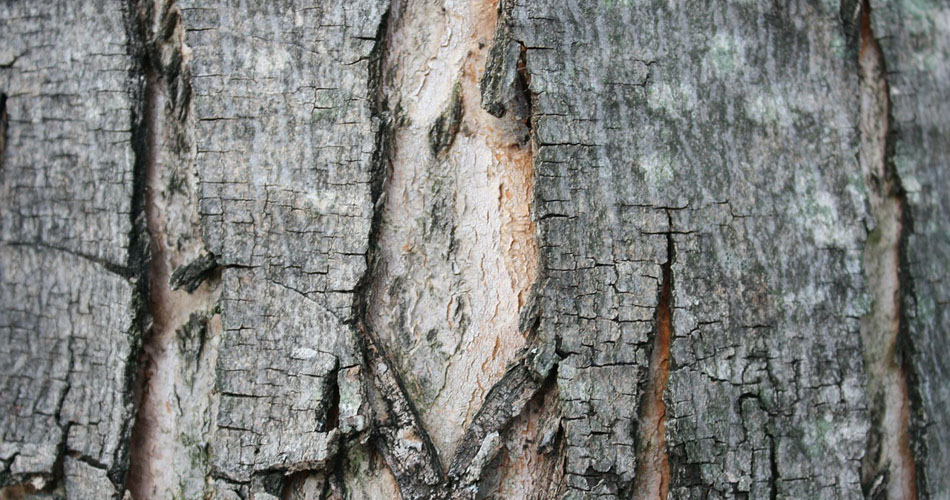
Look for signs of cracked or breaking bark on your trees
If you notice the following, call your arborist –
- Deep cracks or splits in bark
- Cracks exposing underlying wood
- Several cracks in the same area of the tree
- A split or crack extending out beyond an existing wound
- A split or cracked branch that is big enough to cause serious damage if it fails

Dead branches are not only unattractive, they’re also dangerous
DEAD WOOD
Dead wood within a tree’s crown is a danger sign. Properly pruned trees have balanced, open crowns that move in the wind and are more resistant to storm damage. Dead wood can signal internal trunk decay, or that the tree has walled off a large, diseased branch in response to its decay.
Dead wood is not flexible; rather, it’s brittle and can drop at any time. A large branch that has broken off but is still hanging in the tree’s crown is especially dangerous because it’s not attached to anything and can fall without warning.
Don’t let the following go without acting –
- Your tree has a dead central branch, or dead branches stuck in its crown
- Your tree has few or no leaves when it should be producing them (spring and summer)
- A large, dead branch is hanging down
Remember, unless your tree has nothing within its range (its height, measured outward from its trunk base and the spread of its branches), it is a hazard if it has dead wood that drops or if the tree falls over.
CANKERS
If you see areas of missing, sunken, or damaged bark on your tree’s branches or trunk, it may be a canker. Cankers result from diseases or from wound tissue that did not seal off a decayed area.
The canker you see on the outside of a tree’s bark can indicate more extensive internal decay or damage, and can signal that your tree is a hazard.
Call an arborist to evaluate your trees if –
- There is a canker that extends around more than half of the trunk
- A weak branch has a canker, or the trunk near a branch union has one
- There are cankers around existing damage such as bark cracks, wounds, or trunk cavities.
POOR BRANCH UNIONS OR CO-DOMINANT LEADERS
Branches that have poor attachment angles are inherently weaker and more prone to damage and splitting. Trees that have co-dominant leaders, meaning the main trunk divides into two or more competing trunks, also form weak attachment angles.
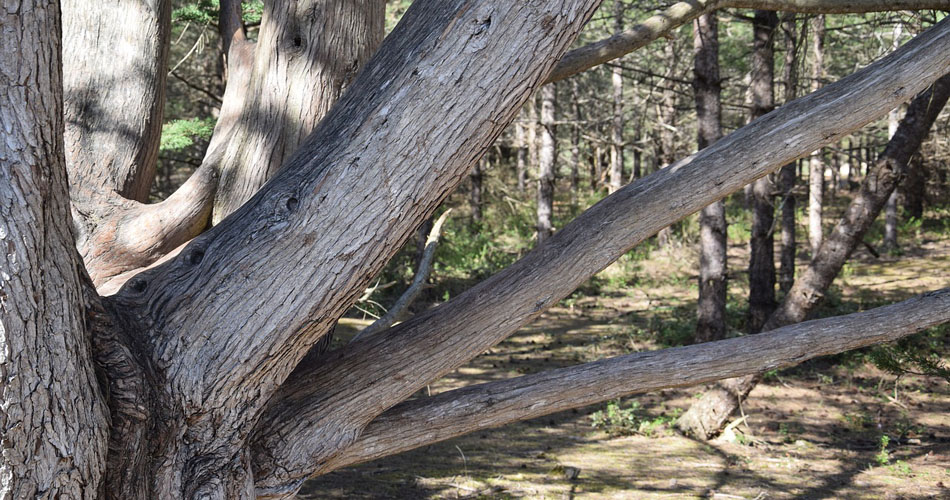
Multi-trunked trees and those with poor branch structure can become hazardous if not properly assessed
When branches grow too closely together, their bark fuses at their base but is not sealed off from damage. You’ve probably seen these branch unions and wanted to give them a good flossing. Debris and moisture collect and attract insects and diseases, compounding the potential of weakly attached branches to decay and become a hazard.
Trees with naturally upright growth patterns are more susceptible to fused or included bark at branch unions, but many species that have not been properly pruned can develop these as well. Bradford pears are notorious for splitting apart in storms because of their narrow branch crotches and weakly-attached branches.
If you see any of the following, call your arborist right away –
- A weak branch attachment, especially one attached to the tree’s trunk
- A weak attachment near an existing wound, crack, or cavity
- Signs of bark splitting at a branch attachment
There may be no visible signs of decay, but poorly attached wood can fall at any time.
DECAY
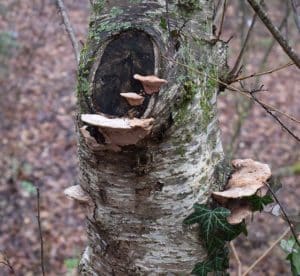
Conks emerging from the tree trunk indicate decay that could cause a tree to fail
Advanced, visible decay is among the most dangerous symptoms of a hazard tree. If you see mushrooms and conks (fungus that looks like a shelf) growing on your tree, or areas of crumbling bark, it can be a sign of internal structural decay. This internal decay may also be hidden because a tree can continue to grow healthy wood and bark over areas of decay. The new growth masks the decay but does not counteract it or the structural damage that can lead to tree failure.
For large trees, such as maples, decay can be more serious because the scale of the tree means its hazard potential is that much greater.
Be sure to call an arborist if you see –
- Decay around branches, bark cracks, or weak branch unions
- Large branches with decay
- Thin layers of new growth over deeper layers of decay along branches
Do not put off getting an evaluation of your tree’s health and structural soundness. The potential damage from falling branches or a falling tree is too great. Leaving damage to work itself out isn’t a solution, as decay won’t stop on its own.
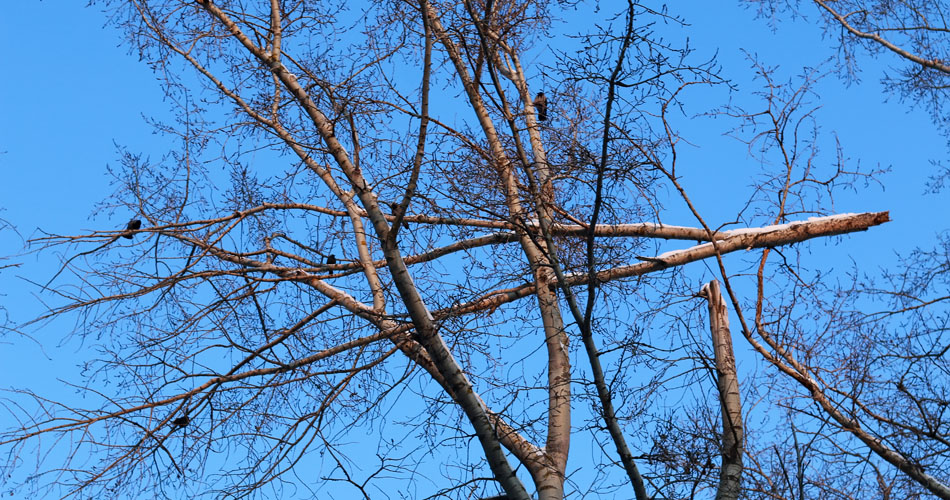
Dead or broken branches can fall at any time, creating a dangerous situation
How to Prevent & Deal With Hazard Trees
There are many steps that can be taken to reduce the chance that a tree will become a hazard and you or your property become targets.
One approach is to evaluate the risk of your trees to potential targets. There are four options to mitigate risk:
Prune your trees. Keep your trees in good shape to reduce their chance of becoming hazards. Along with pruning, regular tree inspections can identify problems early and stop hazardous situations from developing. Corrective pruning removes damaged or decayed branches and can reduce a tree’s size or spread to keep it out of range of nearby targets.
Move targets out of range. If you have items near a tree, such as play equipment or a parked car, moving these things out of a tree’s hazard range is the easiest solution to prevent damage. Moving a target, in combination with corrective pruning or crown reduction, can be a good solution for small spaces.
Create a habitat from a hazard tree. If it’s possible to do so, keeping a tree as a “snag” or wildlife tree is encouraged. After pruning it to a size that reduces its hazard range, the tree can be left standing to provide sheltering habitat for birds and wildlife.
Remove the tree. If cabling and bracing a high-risk tree is done correctly, a tree’s lifespan can be increased by stabilizing its branches or trunk. But cabling and bracing don’t fix a tree’s structural problems, and not every tree is a candidate. When there are no other options but to remove a tree, consider having firewood made from your felled tree, or ask that its wood find a second life as milled lumber for urban woodworkers to use. You can plant another tree in its place, and keep it healthy and well-pruned from the start.
A FINAL WORD
All trees have a lifespan. Urban trees are subjected to poor environmental conditions and pruning damage that forest trees don’t experience and their lifespan may be shortened because of them.
Any of the hazard symptoms listed here can indicate serious defects within your trees. If you see the signs of disease or decay, or conditions that suggest damage is likely, you’ll need to act responsibly and have your trees evaluated by a professional.
While we love trees and work to keep them healthy and vigorous throughout a long lifespan, there is no tree that is so valuable that it puts you, your family and neighbors, or your property at risk.
GET THE LATEST NEWS
Subscribe to the Organic Plant Care Newsletter and get timely and helpful tips and updates monthly.
There's no spam - we promise!





